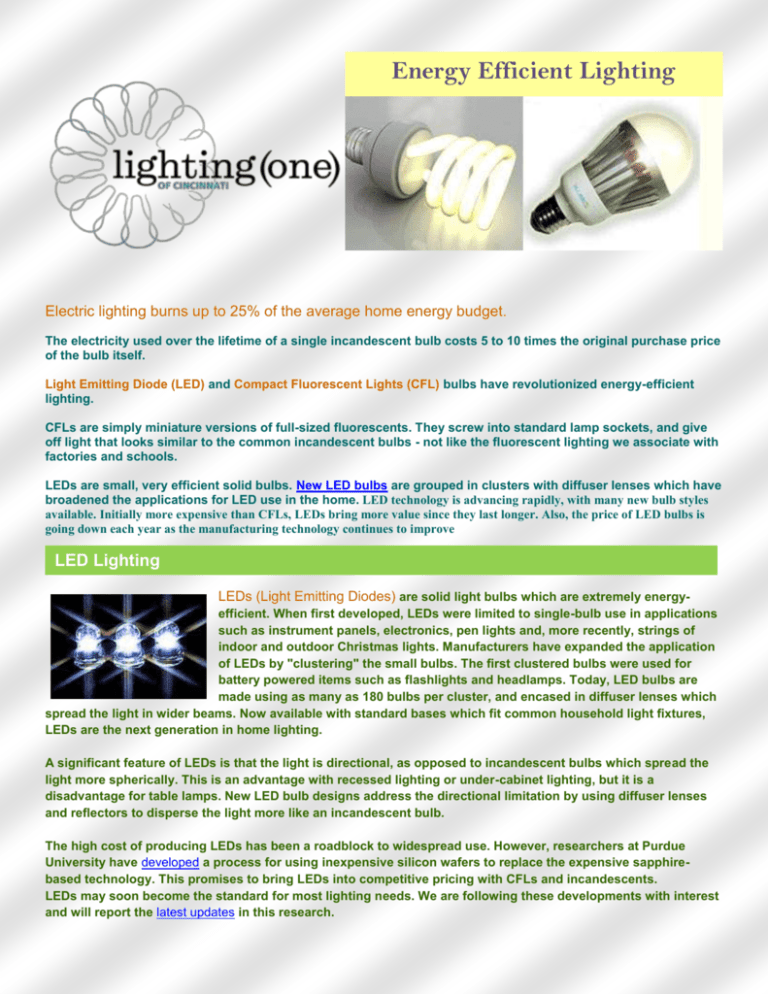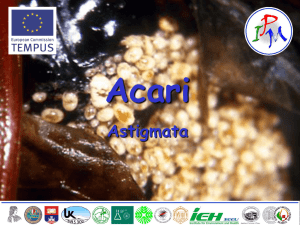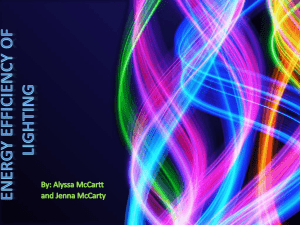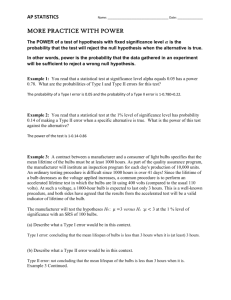File - LightingOne of Cincinnati
advertisement

Energy Efficient Lighting Electric lighting burns up to 25% of the average home energy budget. The electricity used over the lifetime of a single incandescent bulb costs 5 to 10 times the original purchase price of the bulb itself. Light Emitting Diode (LED) and Compact Fluorescent Lights (CFL) bulbs have revolutionized energy-efficient lighting. CFLs are simply miniature versions of full-sized fluorescents. They screw into standard lamp sockets, and give off light that looks similar to the common incandescent bulbs - not like the fluorescent lighting we associate with factories and schools. LEDs are small, very efficient solid bulbs. New LED bulbs are grouped in clusters with diffuser lenses which have broadened the applications for LED use in the home. LED technology is advancing rapidly, with many new bulb styles available. Initially more expensive than CFLs, LEDs bring more value since they last longer. Also, the price of LED bulbs is going down each year as the manufacturing technology continues to improve LED Lighting LEDs (Light Emitting Diodes) are solid light bulbs which are extremely energyefficient. When first developed, LEDs were limited to single-bulb use in applications such as instrument panels, electronics, pen lights and, more recently, strings of indoor and outdoor Christmas lights. Manufacturers have expanded the application of LEDs by "clustering" the small bulbs. The first clustered bulbs were used for battery powered items such as flashlights and headlamps. Today, LED bulbs are made using as many as 180 bulbs per cluster, and encased in diffuser lenses which spread the light in wider beams. Now available with standard bases which fit common household light fixtures, LEDs are the next generation in home lighting. A significant feature of LEDs is that the light is directional, as opposed to incandescent bulbs which spread the light more spherically. This is an advantage with recessed lighting or under-cabinet lighting, but it is a disadvantage for table lamps. New LED bulb designs address the directional limitation by using diffuser lenses and reflectors to disperse the light more like an incandescent bulb. The high cost of producing LEDs has been a roadblock to widespread use. However, researchers at Purdue University have developed a process for using inexpensive silicon wafers to replace the expensive sapphirebased technology. This promises to bring LEDs into competitive pricing with CFLs and incandescents. LEDs may soon become the standard for most lighting needs. We are following these developments with interest and will report the latest updates in this research. Benefits of LED lightbulbs Long-lasting - LED bulbs last up to 10 times as long as compact fluorescents, and far longer than typical incandescents. Durable - since LEDs do not have a filament, they are not damaged under circumstances when a regular incandescent bulb would be broken. Because they are solid, LED bulbs hold up well to jarring and bumping. Cool - these bulbs do not cause heat build-up; LEDs produce 3.4 btu's/hour, compared to 85 for incandescent bulbs. Common incandescent bulbs get hot and contribute to heat build-up in a room. LEDs prevent this heat build-up, thereby helping to reduce air conditioning costs in the home. Mercury-free - no mercury is used in the manufacturing of LEDs. More efficient - LED light bulbs use only 2-17 watts of electricity (1/3rd to 1/30th of Incandescent or CFL). LED bulbs used in fixtures inside the home save electricity, remain cool and save money on replacement costs since LED bulbs last so long. Small LED flashlight bulbs will extend battery life 10 to 15 times longer than with incandescent bulbs. Cost-effective - although LEDs are initially expensive, the cost is recouped over time and in battery savings. LED bulb use was first adopted commercially, where maintenance and replacement costs are expensive. But the cost of new LED bulbs has gone down considerably in the last few years. and are continuing to go down. Today, there are many new LED light bulbs for use in the home, and the cost is becoming less of an issue. To see a cost comparison between the different types of energy-saving light bulbs, see our Light Bulb Comparison Charts. Light for remote areas and portable generators - because of the low power requirement for LEDs, using solar panels becomes more practical and less expensive than running an electric line or using a generator for lighting in remote or off-grid areas. LED light bulbs are also ideal for use with small portable generators which homeowners use for backup power in emergencies. Choosing an LED lightbulb Many different models and styles of LED bulbs are emerging in today's marketplace. When choosing a bulb, keep in mind the following: • Estimate desired brightness - read the package to choose desired brightness level. You can use wattage to compare bulb illumination, for example, a 9W LED is equivalent in output to a 45 W incandescent. However, the new method for comparing bulbs is lumens. Lumens is the measuse of perceived brightness, and the higher the lumens, the brighter the bulb. The FTC has mandated that by 2012 all light bulb packages display lumens as the primary measure for comparing bulbs. For more information about lumens, see LED Terminology further down this page. • Choose between warm and cool light - new LED bulbs are available in 'cool' white light, which is ideal for task lighting, and 'warm' light commonly used for accent or small area lighting. • Standard base or pin base - LEDs are available in several types of 'pin' sockets or the standard "screw' (Edison) bases for recessed or track lighting. • Choose between standard and dimmable bulbs - some LED bulbs, such as the FEIT Electric bulbs, are now available as dimmable bulbs. • Choose high quality bulbs or they will die prematurely - do not buy cheap bulbs from eBay or discounters. They are inexpensive because the bulbs use a low-quality chip which fails easily. • Look for certifications - including FCC, Energy Star and UL. The common styles of LED bulbs include the following: Diffused bulbs In this style LED bulb, clusters of LEDs are covered by a dimpled lens which spreads the light out over a wider area. Available in standard Edison bases, these bulbs have many uses, such as area lighting for rooms, porches, reading lamps, accent lamps, hallways and low-light applications where lights remain on for extended periods. Click for more information or to buy Diffused LED Bulbs Dimmable Globe LED bulbs Designed for bathroom vanities or anywhere a globe bulb is required, these bulbs produce light equivalent to a 40-watt incandescent bulb, yet only consume 10 watts of power. Dimmable from 100% to 10%, these bulbs have a 200 degree beam angle to cast light in a wide area. Click for more information or to buy Dimmable Globe LED Bulbs Track Lighting, pin base Available in MR-16 (pin base), LEDs are ideal for track lighting. LEDs do not contribute to heat buildup in a room because no matter how long they remain on, they do not get hot to the touch. Also, because they are 90% more efficient than incandescents, and last 10 times longer than CFLs, the frequency of changing bulbs is greatly reduced. Click for more information or to buy Track Lighting pin-base LED bulbs Flood Reflector LEDs for Recessed Cans and Track lights, screw-in base LEDs are now available for standard recessed lighting pots and housings. They range from 7.5 to 17watts, with beam widths from PAR20 to PAR38. Several models are dimmable. Also, because they are 90% more efficient than incandescents. and last 10 times longer than CFLs, the frequency of changing bulbs is greatly reduced. Click for more information or to buy Flood reflector LED bulbs Flame Tip, Candelabra Base LEDs Designed to replace incandescent candelabra bulbs, these flame tip LEDs deliver the equivalent light of 25 - 35 watt incandescents while only drawing 3.5 watts of electricity. Because of the heat sink in the base, light doesn't disperse downwards as much as a typical incandescent candelabra bulb. Click for more information or to buy Flame tip candelabra LEDs LED Tube Lights Designed to replace fluorescent tube bulbs, these LED tubes are available in 8 and 16 watts, which replace traditional 25-watt and 40-watt T8/T10/T12 fluorescent tubes. Because fluorescent lights are often installed in high ceilings in commercial sites, there are additional savings because the frequency of changing bulbs is greatly reduced. Click for more information or to buy LED Tube Lights LED Terminology Coloring Rendering Index (CRI) - CRI represents the quality of light and its faithfulness to render colors correctly, that is, to enable us to perceive colors as we know them. The ideal CRI is 100, and some incandescent bulbs approach this level. LEDs and CFLs use different design components in trying to equal the CRI of incandescent bulbs. LED bulbs CRI ratings range from 70 to 95, and the best CFLs have ratings in the mid 80s. The LED CREE CR6 bulb, for example, features a CRI of 90 Warm White making it one of the highest in the industry. Correlated Color Temperature (CCT) - is the measure used to describe the relative color appearance of a white light source. CCT indicates whether a light source appears more yellow/gold/orange or more blue, in terms of the range of available shades of "white." CCT is given in kelvins (unit of absolute temperature). 2700K is "Warm" and 5000K is "Cool". The typical light color we are used to in indoor home lighting is "warm", 2700 - 2800K. Lumen - a unit of standard measurement that is used to describe the amount of light contained in an area as perceived by the human eye. The more lumens, the brighter the light. You can use lumens to compare the brightness of any bulb, regardless of the technology behind it, and regardless of whether it's incandescent, CFL or LED. Luminous Flux - the flow of light measured in lumens. With light bulbs, it provides an estimate of the apparent amount of light the bulb will produce. Depending on the application, much of an incandescent's light is wasted because it's emitted in every direction. LED bulbs, on the other hand, put out directional light, sending all of the light exactly where it's needed. In practical application, when buying a light bulb, we should look for bhlbs which produce more light but consumes less energy. Understanding lumens as a measure of brightness makes it easier to select the most efficient bulb for your application. This is also important LED Bulb Colors Most LED bulbs in use today are clear or white bulbs, commonly available in 'cool' or 'warm' white light. But LEDs are also available in colors and used as individual bulbs, or in clusters, for special applications. Red - Red is the traditional color for maintaining night vision. Some LED headlamps and flashlights have the option of switching to red light for use at night. Green - Green is now the preferred color for pilots and the military. The green color is also great for retaining night vision, and it doesn'’ t erase, or render invisible, the red markings on maps and charts. Blue - Many people like the blue because it is very easy on the eyes. Blue appears to be a good reading light for elderly eyes. Elderly folks report that they can read under the blue light for hours without eyestrain, compared to severe eyestrain in less than 30 minutes with incandescent lighting. White - The most popular of the LED colors. It produces a soft white light, without harsh reflection, glare or shadows. Amber - LED amber bulbs do not attract flying insects, as do ordinary white bulbs. Amber LEDs are used outdoors in areas such as patios and decks where insects flying around lights are a nuisance. Lumen Output: Comparing LED vs CFL vs Incandescent Wattage Did you know watts don't tell you how bright a light will be? To compare different light bulbs, you need to know about lumens. Lumens, not watts, tell you how bright a light bulb is, no matter the type of bulb. The more lumens, the brighter the light. Beginning in 2012, labels on the front of light bulb packages now state a bulb's brightness in lumens, instead of the bulb's energy usage in watts. For more information, read our article Lumens are the new watts. While lumens is the best measurement of comparative lighting among the various bulbs, it is not always a perfect measure. Some floodlights in can lighting use an internal reflector in the bulb to send the light facing downward. When shopping for light bulbs, note that bulbs equipped with reflectors will deliver increased directional light. The chart below shows the amount of brightness in lumens you can expect from different wattage light bulbs. The LED bulbs require much less wattage than the CFL or Incandescent light bulbs, which is why LED bulbs are more energy-efficient and long lasting than the other types of bulb. Incandescent Watts CFL Watts LED Watts Lumens (Brightness) 40 60 75 - 100 100 150 8 - 12 13 - 18 18 - 22 23 -30 30 - 55 6-9 8 - 12.5 13+ 16 - 20 25 - 28 400 - 500 650 - 900 1100 - 1750 1800+ 2780 CFL Lighting: Benefits Efficient: CFLs are four times more efficient and last up to 10 times longer than incandescents. A 22 watt CFL has about the same light output as a 100 watt incandescent. CFLs use 50 - 80% less energy than incandescents. Less Expensive: Although initially more expensive, you save money in the long run because CFLs use 1/3 the electricity and last up to 10 times as long as incandescents. A single 18 watt CFL used in place of a 75 watt incandescent will save about 570 kWh over its lifetime. At 8 cents per kWh, that equates to a $45 savings. Reduces Air and Water Pollution: Replacing a single incandescent bulb with a CFL will keep a half-ton of CO2 out of the atmosphere over the life of the bulb. If everyone in the U.S. used energy-efficient lighting, we could retire 90 average size power plants. Saving electricity reduces CO2 emissions, sulfur oxide and high-level nuclear waste. High-Quality Light: Newer CFLs give a warm, inviting light instead of the "cool white" light of older fluorescents. They use rare earth phosphors for excellent color and warmth. New electronically ballasted CFLs don't flicker or hum. Versatile: CFLs can be applied nearly anywhere that incandescent lights are used. Energy-efficient CFLs can be used in recessed fixtures, table lamps, track lighting, ceiling fixtures and porchlights. 3-way CFLs are also now available for lamps with 3-way settings. Dimmable CFLs are also available for lights using a dimmer switch. CFL Light Bulb Models CFLs are available in a variety of styles or shapes. Some have two, four, or six tubes. Older models, and specialty models, have separate tubes and ballasts. Some CFLs have the tubes and ballast permanently connected. This allows you to change the tubes without changing the ballast. Others have circular or spiral-shaped tubes. In general, the size or total surface area of the tube determines how much light the bulb produces. The following CFL bulb models come with standard sockets for easy installation in most common household applications. Spiral Lamps These bulbs are designed as a continuous tube in a spiral shape which has similar outside shape and light casting qualities to a standard incandescent bulb. Spiral CFL bulbs are made in several sizes to fit most common fixtures. Triple Tube Lamps These CFLs have more tubing in a smaller area, which generates even more light in a shorter bulb. They pack high light output into a very small space and can be used in fixtures designed for incandescent bulbs, such as table lamps, reading lamps, open hanging lamps, and bare bulb applications. Standard Lamps These are regular CFL spiral lamps which are placed inside a dome cover and fitted with a standard base which fits common lamp sockets. They are designed to give the appearance of the traditional light bulb for consumers looking for the more familiar light bulb appearance. The glass diffuser provides a quality of light similar to the 'soft-white' type of incandescent bulbs. Globe Lamps This shape is commonly used in bathroom vanity mirrors or open hanging lamps, and bare bulb applications. Bathroom vanities usually require multiple bulbs, which generate radiant heat. The CFL globe will reduce this heat buildup while saving energy. The glass diffuser provides a softwhite light. Flood Lamps These lamps are designed to be ideal for recessed and track lighting fixtures, indoors and outdoors. They provide diffused, soft, white light, and generate less heat than will an incandescent flood or a halogen bulb. CFL flood lamps are available in varying sizes and wattages Candelabra The screw-in torpedo-shape and the small-base of this bulb is designed for smaller light fixtures throughout the house, from chandeliers to sconces. To use a smaller candelabra-based bulb in a regular socket, you can use a socket reducer. Limitations of CCL lightbulbs Although CFLs are an excellent source of energy-efficient lighting, they are not always the best choice for all lighting applications. Here are a few limitations to consider: On/Off cycling: CFLs are sensitive to frequent on/off cycling. Their rated lifetimes of 10,000 hours are reduced in applications where the light is switched on and off very often. Closets and other places where lights are needed for brief illumination should use incandescent or LED bulbs. Dimmers: Dimmable CFLs are available for lights using a dimmer switch, but check the package; not all CFLs can be used on dimmer switches. Using a regular CFL with a dimmer can shorten the bulb life span. Outdoors: CFLs can be used outdoors, but should be covered or shaded from the elements. Low temperatures may reduce light levels - check the package label to see if the bulb is suited for outdoor use. Retail lighting: CFLs are not spot lights. Retail store display lighting usually requires narrow focus beams for stronger spot lighting. CFLs are better for area lighting. Mercury content: CFLs contain small amounts of mercury which is a toxic metal. This metal may be released if the bulb is broken, or during disposal. For more information about mercury and CFLs, see below. The principle reason for reduced lifespan of CFLs is heat. CFLs exhibit shorter lifespans in light fixtures and sockets where there is low air-flow and heat build-up such as recessed lighting. For these types of sockets it is recommended to ues specially designed CFLs for recessed lighting or LEDs. Another main reason for reduced lifespan of CFLs is too-frequent on/off cycling. These bulbs should be used where they will be left on for steady periods without being flicked on and off. Mercury and CFLs Mercury is a toxic metal associated with contamination of water, fish, and food supplies, and can lead to adverse health affects. A CFL bulb generally contains an average of 5 mg of mercury (about one-fifth of that found in the average watch battery, and less than 1/100th of the mercury found in an amalgam dental filling). A power plant will emit 10mg of mercury to produce the electricity to run an incandescent bulb compared to only 2.4mg of mercury to run a CFL for the same time. The net benefit of using the more energy efficient lamp is positive, and this is especially true if the mercury in the fluorescent lamp is kept out of the waste stream when the lamp expires. Handling and Disposal of CFLs The mercury in compact fluorescent bulbs poses no threat while in the bulb, but if you break one: - open a window and leave the room for 15 minutes or more - use a wet rag to clean it up and put all of the pieces, and the rag, into a plastic bag - place all materials in a second sealed plastic bag - call your local recycling center to see if they accept this material, otherwise put it in your local trash. Wash your hands afterward. Burned out CFLs can be dropped off at Home Depot and Ikea stores. Another solution is to save spent CFLs for a community household hazardous waste collection, which would then send the bulbs to facilities capable of treating, recovering or recycling them. For more information on CFL disposal or recycling, you can contact your local municipality.








